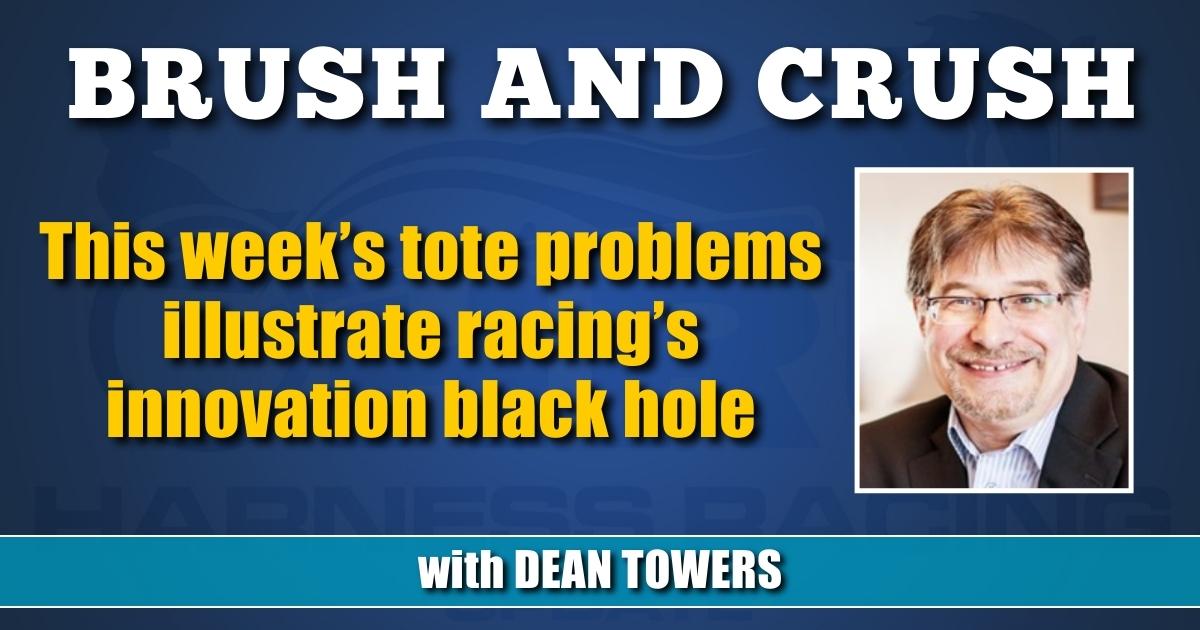

This week’s tote problems illustrate racing’s innovation black hole
Intransigent structures and systems along with a lack of vision continue to cripple the sport’s growth.
by Dean Towers
Earlier this week, a “glitch” in how wagers were sent from FanDuel to the tote caused quite the ruckus in horse racing wagering pools, including at several harness tracks.
The coding problem allowed for wagers to be sent at the base rate, rather than the total cost of the ticket. So, if someone took a 20 cent all-all-all-all superfecta in a seven-horse field, the ticket cost was 20 cents, not $168.
As initially reported by Ed DeRosa of Horse Racing Nation, this resulted in some astronomical pool sizes. At The Meadows, a superfecta which usually handles about $10,000 ballooned to over $1 million. At Monticello, a superfecta pool approached a mind boggling $1.5 million.
This was certainly eye-opening to many, but in my view it should not have been. This has been a characteristic of the betting side of this industry for decades.
Recently appointed head of the National Thoroughbred Alliance, Pat Cummings, shared some excellent thoughts about the incident on a twitter thread on Friday.
“That a single customer could ‘wager’ hundreds of thousands in succession, across multiple tracks and countries, and most of those tracks just rolled along shows you where we stand,” Cummings said. “Regulators, operators, ADWs, tote companies… everyone is in play on blame, not just FanDuel.”
I couldn’t agree more.
The term “innovation” is often misunderstood to mean eureka moments, or some sort of invention by one person in a lonely lab or basement somewhere. As Matt Ridley detailed in his immaculately researched book, “How Innovation Works“, this is not the case.
Innovating involves dozens and sometimes hundreds of iterations; it’s incremental, responding to needs and wants of a market through collaboration and trial and error. No one person invented a light bulb, or a lead pencil. They evolved.
Almost every innovation many of us take for granted developed through a bottom-up, not a top-down approach.
Most have heard of the Stephenson Rocket, the world’s first locomotive, but it was not invented by the famous brothers, its prototype had been invented over a quarter century earlier by someone else.
Often, the hope of an innovation is not the end result. Collaboration and open markets change goals, or the substance of new initiatives.
The founders of Twitter were not trying to create the world’s largest short-form communication medium, they were looking for a website where people could easily find podcasts. Instagram was founded to be a gaming app, not where we find a clip of Taylor Swift backstage, or the latest way to bake a cake. Ironically, fracking might end up being a catalyst towards clean, renewable energy, because two sharp MIT engineers used the fundamentals of hydraulic fracturing to move turbines through pressurized water in Texas.
What’s my point as it pertains to horse racing?
The tote system has never been constructed, or able, to foster this type of innovation, i.e., the only innovation that works.
The system — AmTote was created in the late 1920s — is not driven by a market, but by an entity. And in 2023 that entity is controlled (and in many cases hamstrung) by several other fiefdoms, that can involve tracks, horsemen, or states.
The system has surely innovated — we have new bets, and it has expanded to world-wide markets — but truth be told, this is the same system that allowed the “Fix Six” Breeders’ Cup scandal, and 20 or so years later was at least some part of this week’s problems. It’s also the same structure that allows for huge odds changes we all see almost each and every harness race, sometimes after the race is being run.
This lack of open, dynamic innovation causes more than those obvious drawbacks which anger our dwindling customer base. In my view, it stunts growth and opportunity.
Horse racing has tried to enter the sports betting space, but on the sports betting platform’s terms. Being last to market is never a good idea, and Churchill Downs Inc has already abandoned its BetAmerica hub; the industry has moved to rent seeking behavior in sports betting, by tagging along as a form of subsidy.
Because the tote lacks innovation (or cooperation of its partners to lobby) in broad ways, it was never able to create, for example, its own platform for pari-mutuel sports betting.
In sports betting, parlay markets are already huge and growing. Tote technology, where people could easily wager pari-mutuelly on Formula 1 exactas or trifectas, or betting superfecta boxes on the Masters, or U.S. Open could be a massive opportunity.
Most of us might be tempted to look at this week’s coding glitch, hope the problem is fixed and then move along. But to me this misses the big picture.
Horse racing itself is insular. It rarely looks outside to see what’s possible, but even if it does, it hits a brick wall of fiefdom or alphabet bloat. This is the cause of the innovation black hole, and it is what horse racing needs to address.
A structure and culture of innovation, whether it’s related to the tote, exchanges, or horse racing data, is hard and it doesn’t guarantee success. But just like with light bulbs, lead pencils and locomotives, it at the very least gives it a chance.















